Valorification of Ulva rigida Algae in Pulp and Paper Industry for Improved Paper Characteristics and Wastewater Heavy Metal Filtration
Abstract
:1. Introduction
2. Materials and Methods
2.1. Material
2.1.1. Stranded Macrophytes Comprising the Species Ulva rigida
2.1.2. Cellulosic Fibers from Softwoods and Hardwoods
2.1.3. Wastewater from the Metallurgical Industry
2.2. Methods
2.2.1. Technical Steps and Equipment Used for Papermaking
2.2.2. Determination of the Structural Characteristics of Filter Paper with Added Macrophytic Marine Algae
- Determination of grammage
- Determination of thickness
- Determination of apparent specific volume of the sample
- Determination of air permeance, Gurley method
- Determination of smoothness, Bekk method
- Determination of residue (ash content)
- SEM–EDX determinations
2.2.3. Determination of the Mechanical Strength Characteristics of Filter Paper with Added Macrophyte Marine Algae
- Determination of Breaking Load
- Determination of Breaking Length
- Determination of tearing resistance, Elmendorf method
- Determination of bursting strength
- Determination of folding endurance
2.2.4. Determination of the Absorption Characteristics of Filter Paper with Added Macrophyte Marine Algae
- Determination of water absorptiveness, Cobb method
- Determination of the moisture
2.2.5. Determination of the Filtration Capacity of Heavy Metals, TDS and TSS from the Wastewater
- Determination of heavy metals
- Determination of TDS and TSS
- Wastewater filtration
3. Results
3.1. Determination of the Structural Characteristics of Filter Paper with Added Macrophytic Marine Algae
- Determination of grammage
- Determination of thickness
- Determination of sample apparent specific volume
- Determination of air permeance, Gurley method
- Determination of smoothness, Bekk method
- Determination of residue (ash content)
3.2. Determination of the Mechanical Strength Characteristics of Filter Paper with Added Macrophyte Marine Algae
- Determination of breaking load
- Determination of Breaking Length
- Determination of tearing resistance, Elmendorf method
- Determination of bursting strength
- Determination of folding endurance
3.3. Determination of the Absorption Characteristics of Filter Paper with Added Marine Macrophyte Algae
- Determination of water absorptiveness, Cobb method
- Determination of the moisture
3.4. SEM–EDX Morphological and Elemental Characterization of Filter Paper with Added Macrophyte Marine Algae
3.5. Determination of the Paper Filtration Capacity of Heavy Metals, TDS and TSS from the Wastewater
- Determination of total Cr concentrations from the wastewater and after filtration test
- Determination of Cu concentrations from the wastewater and after filtration test
- Determination of total Fe concentrations from the wastewater and after filtration test
- Determination of Zn concentrations from the wastewater and after filtration test
- Determination of TDS concentrations from the wastewater and after filtration test
- Determination of TSS concentrations from the wastewater and after filtration test
4. Conclusions
Supplementary Materials
Author Contributions
Funding
Institutional Review Board Statement
Informed Consent Statement
Data Availability Statement
Acknowledgments
Conflicts of Interest
References
- Lembi, C.A. 24-Control of nuisance algae. In Freshwater Algae of North America; Wehr, J.D., Sheath, R.G., Eds.; Academic Press: Burlington, NJ, USA, 2003; pp. 805–834. [Google Scholar] [CrossRef]
- Chapman, R.L. Algae: The world’s most important “plants”—An introduction. Mitig. Adapt. Strateg. Glob. Chang. 2013, 18, 5–12. [Google Scholar] [CrossRef] [Green Version]
- Alba, K.; Kontogiorgos, V. Seaweed Polysaccharides (Agar, Alginate Carrageenan). In Encyclopedia of Food Chemistry; Melton, L., Shahidi, F., Varelis, P., Eds.; Academic Press: Oxford, UK, 2019; pp. 240–250. [Google Scholar] [CrossRef]
- Caprita, F.; Ene, A. Valorification directions for marine algae. Ann. Univ. Dunarea De Jos Galati Fasc. II Math. Phys. Mec. Theor. 2019, 42, 10–18. [Google Scholar] [CrossRef]
- McHugh, D.J. Introduction to commercial seaweeds. In A Guide to the Seaweed Industry; Food & Agriculture Organization of the United Nations (FAO): Rome, Italy, 2003; Volume 441, pp. 1–6. [Google Scholar]
- Balina, K.; Romagnoli, F.; Pastare, L.; Blumberga, D. Use of macroalgae for bioenergy producíon in Latvia: Review on potential availability of marine coastline species. Energy Procedia 2017, 113, 403–410. [Google Scholar] [CrossRef]
- Aitken, D.; Bulboa, C.; Godoy-Faundez, A.; Turrion-Gomez, J.L.; Antizar-Ladislao, B. Life cycle assessment of macroalgae cultivation and processing for biofuel production. J. Clean. Prod. 2014, 75, 45–56. [Google Scholar] [CrossRef]
- Bruton, T.; Lyons, H.; Lerat, Y.; Stanley, M.; Rasmussen, M.B. A Review of the Potential of Marine Algae as a Source of Biofuel in Ireland; Sustainable Energy Ireland: Dublin, Ireland, 2009; pp. 1–88. Available online: https://cdn.technologynetworks.com/TN/Resources/PDF/algae%20report%2004%202009.pdf (accessed on 7 February 2021).
- Bayu, A.; Handayani, T. High-value chemicals from marine macroalgae: Opportunities and challenges for marine-based bioenergy development. IOP Conf. Ser. Earth Environ. Sci. 2018, 209, 12046. [Google Scholar] [CrossRef]
- Chen, H.; Zhou, D.; Luo, G.; Zhang, S.; Chen, J. Macroalgae for biofuels production: Progreess and perspectives. Renew. Sustain. Energy Rev. 2015, 47, 427–437. [Google Scholar] [CrossRef]
- Bilal, M.; Rasheed, T.; Sosa Hernández, J.E.; Raza, A.; Nabeel, F.; Iqbal, H. Biosorption: An Interplay between Marine Algae and Potentially Toxic Elements—A Review. Mar. Drugs 2018, 16, 65. [Google Scholar] [CrossRef] [Green Version]
- Romera, E.; González, F.; Ballester, A.; Blázquez, M.L.; Muñoz, J.A. Biosorption With Algae: A Statistical Review. Crit. Rev. Biotechnol. 2006, 26, 223–235. [Google Scholar] [CrossRef] [PubMed]
- Romera, E.; González, F.; Ballester, A.; Blázquez, M.L.; Muñoz, J.A. Comparative study of biosorption of heavy metals using different types of algae. Bioresour. Technol. 2007, 98, 3344–3353. [Google Scholar] [CrossRef] [PubMed]
- Beni, A.A.; Esmaeili, A. Biosorption, an efficient method for removing heavy metals from industrial effluents: A Review. Environ. Technol. Innov. 2020, 17, 100503. [Google Scholar] [CrossRef]
- Caprita, F.; Ene, A. Biosorption of heavy metals from the metallurgical industry wastewater by macroalgae. AIP Conf. Proc. 2020, 2218, 030011. [Google Scholar] [CrossRef]
- He, J.; Chen, J.P. A comprehensive review on biosorption of heavy metals by algal biomass: Materials, performances, chemistry, and modeling simulation tools. Bioresour. Technol. 2014, 160, 67–78. [Google Scholar] [CrossRef]
- Santhi, T.; Manonmani, S.; Smitha, T. Removal of malachite green from aqueous solution by activated carbon prepared from the epicarp of Ricinuscommunis by adsorption. J. Hazard. Mater. 2010, 179, 178–186. [Google Scholar] [CrossRef]
- Gonçalves, A.C., Jr.; Schwantes, D.; Campagnolo, M.A.; Dragunski, D.C.; Tarley, C.R.T.; Silva, A.K.D.S. Removal of toxic metals using endocarp of açaí berry as biosorbent. Water Sci. Technol. 2018, 77, 1547–1557. [Google Scholar] [CrossRef] [PubMed] [Green Version]
- Pereira de Sá, C.H.; da Silva, M.G.C.; Gurgel Adeodato, V.M. Biosorption of aluminum ions from aqueous solutions using non-conventional low-cost materials: A review. J. Water Process. Eng. 2021, 40, 101925. [Google Scholar] [CrossRef]
- Saif, S.; Tahir, A.; Chen, Y. Green Synthesis of Iron Nanoparticles and Their Environmental Applications and Implications. Nanomaterials 2016, 6, 209. [Google Scholar] [CrossRef] [Green Version]
- Bhatnagar, A.; Minocha, A.K. Biosorption optimization of nickel removal from water using Punica granatum peel waste. Colloids Surf. B 2010, 76, 544–548. [Google Scholar] [CrossRef]
- Areco, M.M.; Salomone, V.N.; María dos Santos, A. Ulva lactuca: A bioindicator for anthropogenic contamination and its environmental remediation capacity. Mar. Environ. Res. 2021, 171, 105468. [Google Scholar] [CrossRef]
- Conti, M.E.; Cecchetti, G. A biomonitoring study: Trace metals in algae and molluscs from Tyrrhenian coastal areas. Environ. Res. 2003, 93, 99–112. [Google Scholar] [CrossRef]
- Doshi, H.; Seth, C.; Ray, A.; Kothari, I.L. Bioaccumulation of heavy metals by green algae. Curr. Microbiol. 2008, 56, 246–255. [Google Scholar] [CrossRef]
- Wang, J.; Chen, C. Biosorbents for heavy metals removal and their future. Biotechnol. Adv. 2009, 27, 195–226. [Google Scholar] [CrossRef]
- Kordialik-Bogacka, E.; Smolińska, B.; Cedzyńska, K.; Ambroziak, W. Regeneration of biomass used in the biosorption of cadmium. New Biotechnol. 2009, 25, S375. [Google Scholar] [CrossRef]
- Pop, C.-E.; Draga, S.; Măciucă, R.; Niță, R.; Crăciun, N.; Wolff, R. Bisphenol A Effects in Aqueous Environment on Lemna minor. Processes 2021, 9, 1512. [Google Scholar] [CrossRef]
- Kuncoro, E.; Soedarti, T.; Putranto, T.; Darmokoesoemo, H.; Abadi, N.; Kusuma, H. Characterization of a mixture of algae waste-bentonite used as adsorbent for the removal of Pb2+ from aqueous solution. Data Brief 2017, 16, 908–913. [Google Scholar] [CrossRef] [PubMed]
- Mossbauer, M.; Haller, I.; Dahlke, S.; Schernewski, G. Management of stranded eelgrass and macroalgae along the German Baltic coastline. Ocean Coast Manag. 2012, 57, 1–9. [Google Scholar] [CrossRef]
- Fahmy, Y.; Fahmy, T.; Mobarak, F.; El-Sakhawy, M.; Fadl, M.H. Agricultural Residues (Wastes) for Manufacture of Paper, Board, and Miscellaneous Products: Background Overview and Future Prospects. Int. J. Chemtech Res. 2017, 10, 424–448. [Google Scholar] [CrossRef]
- Jiménez, L.; Rodríguez, A.; Pérez, P.; Moral, A.; Serrano, L. Alternative raw materials and pulping process using clean technologies. Ind. Crop. Prod. 2008, 28, 11–16. [Google Scholar] [CrossRef]
- Nassar, M.; Rahman, H.M.E.; El Sahkawy, M. An optimum mixture of virgin rice straw pulp and recycled old newsprint (ONP) pulp and their antimicrobial activity. Indian J. Biotechnol. 2015, 11, 63–71. [Google Scholar] [CrossRef]
- Shatalov, A.A.; Pereira, H. Influence of stem morphology on pulp and paper properties of Arundo donax L. reed. Ind. Crops Prod. 2002, 15, 77–83. [Google Scholar] [CrossRef]
- Cabalova, I.; Kačík, F.; Geffert, A.; Kačíková, D. The Effects of Paper Recycling and its Environmental Impact. In Environmental Management in Practice; Broniewicze, E., Ed.; IntechOpen: London, UK, 2011; Available online: https://www.intechopen.com/chapters/16296 (accessed on 10 August 2021)ISBN 978-953-307-358-3. [CrossRef] [Green Version]
- Jerusik, R.J. Fungi and paper manufacture. Fungal Biol. Rev. 2010, 24, 68–72. [Google Scholar] [CrossRef]
- Sousa-Silva, M.; Vieira, D.; Soares, P.; Casal, M.; Soares-Silva, I. Expanding the Knowledge on the Skillful Yeast Cyberlindnera jadinii. J. Fungi 2021, 7, 36. [Google Scholar] [CrossRef] [PubMed]
- Buerth, C.; Tielker, D.; Ernst, J.F. Candida utilis and Cyberlindnera (Pichia) jadinii: Yeast relatives with expanding applications. Appl. Microbiol. Biotechnol. 2016, 100, 6981–6990. [Google Scholar] [CrossRef] [PubMed]
- AbuBakr, S.; Thompson, J.R. PAPERMAKING The History of Paper and Papermaking. In Encyclopedia of Forest Sciences; Burley, J., Ed.; Elsevier: Oxford, UK, 2004; pp. 691–694. [Google Scholar] [CrossRef]
- Bhojvaid, P.P.; Rai, A.K. PAPERMAKING Paper Raw Materials and Technology. In Encyclopedia of Forest Sciences; Burley, J., Ed.; Elsevier: Oxford, UK, 2004; pp. 701–707. [Google Scholar] [CrossRef]
- Confederation of European Paper Industries. Cepi Statistics, KEY STATISTICS 2019 European Pulp & Paper Industry. Available online: https://www.cepi.org/wp-content/uploads/2020/07/Final-Key-Statistics-2019.pdf (accessed on 22 March 2021).
- Moral, A.; Aguado, R.; Castelló, R.; Tijero, A.; Ballesteros, M. Potential use of green alga Ulva sp. for papermaking. BioResources 2019, 14, 6851–6862. [Google Scholar] [CrossRef]
- González Pereira, A.; Corral, M.; García Oliveira, P.; Lourenço-Lopes, C.; Rodríguez, M.; Prieto Lage, M.; Simal-Gandara, J. The Use of Invasive Algae Species as a Source of Secondary Metabolites and Biological Activities: Spain as Case-Study. Mar. Drugs 2021, 19, 178. [Google Scholar] [CrossRef]
- Google Maps. Available online: https://www.google.com/maps/@44.170343,28.662744,74m/data=!3m1!1e3?hl=en-US (accessed on 3 February 2021).
- SR ISO 5264-1:1997, Pulps, Laboratory Beating—Part 1: Valley Beater Method, ICS 85.040. Available online: https://www.sis.se/en/produkter/paper-technology/pulps/iso52641/ (accessed on 22 March 2021).
- SR EN ISO 5267-1:2002, Pulps, Determination of Drainability—Part 1: Schopper-Riegler method, ICS 85.040. Available online: https://standards.iteh.ai/catalog/standards/sist/03c80711-1a02-4ef7-9d40-da56def91cc9/sist-iso-5267-1-2002 (accessed on 22 March 2021).
- SR EN 20187:1996, Pulp, Paper and Board, Standard Atmosphere for Conditioning and Testing and Procedure for Monitoring the Atmosphere and Conditioning Samples, ICS 85.040, ICS 85.060. Available online: https://www.iso.org/standard/4037.html (accessed on 13 March 2021).
- SR EN ISO 536:2020, Paper and Board, Determination of Grammage, ICS85.060. Available online: https://www.en-standard.eu/bs-en-iso-536-2020-paper-and-board-determination-of-grammage/ (accessed on 13 March 2021).
- SR EN ISO 534:2012, Paper and Board, Determination of Thickness, Density and Specific Volume, ICS 85.060. Available online: https://www.en-standard.eu/une-en-iso-534-2012-paper-and-board-determination-of-thickness-density-and-specific-volume-iso-534-2011/ (accessed on 23 March 2021).
- ISO 5636-5:2013, Paper and Board, Determination of Air Permeance (Medium Range)—Part 5: Gurley Method ICS 85.060. Available online: https://www.iso.org/standard/53062.html (accessed on 24 March 2021).
- ISO 5627:1995/COR 1:2002, Paper and Board, Determination of Smoothness (Bekk Method)—Technical Corrigendum 1 ICS 85.060. Available online: https://www.iso.org/standard/36977.html (accessed on 24 March 2021).
- ISO 2144:2019, Paper, Board, Pulps and Cellulose Nanomaterials, Determination of Residue (ASH content) on Ignition at 900 °C, ICS 85.060. Available online: https://www.iso.org/standard/73415.html (accessed on 24 March 2021).
- Ene, A.; Gheorghies, C.; Frontasyeva, M.V. X-ray based techniques used in materials analysis and control. In Proceedings of the 17th International conference New Technologies and Products in Machine Manufacturing Technologies-Tehnomus XVII, Suceava, Romania, 17–18 May 2013; Volume 1, pp. 193–196. Available online: http://www.tehnomusjournal.fim.usv.ro/en/pagini/journal2013/files/33.pdf (accessed on 28 July 2021).
- Ignatenko, O.V.; Komar, V.A.; Leonchik, S.V.; Shempel, N.A.; Ene, A.; Cantaragiu, A.; Frontasyeva, M.V.; Shvetsov, V.N. Changes of nitrides characteristics in Li-N system synthesized at different pressures. J. Alloys Compd. 2013, 581, 23–27. [Google Scholar] [CrossRef]
- SR EN ISO 1924-2:2009, Paper and Board, Determination of Tensile Properties—Part 2: Constant Rate of Elongation Method (20 mm/min), ICS 85.060. Available online: https://www.en-standard.eu/une-en-iso-1924-2-2009-paper-and-board-determination-of-tensile-properties-part-2-constant-rate-of-elongation-method-20-mm-min-iso-1924-2-2008/ (accessed on 24 March 2021).
- ISO 3781:2011, Paper and Board, Determination of Tensile Strength after Immersion in Water, ICS 85.060. Available online: https://www.iso.org/standard/56090.html (accessed on 24 March 2021).
- SR EN ISO 1974:2012, Paper, Determination of Tearing Resistance—Elmendorf Method, ICS 85.060. Available online: https://www.iso.org/standard/52430.html (accessed on 24 March 2021).
- SR EN ISO 2758:2015, Paper, Determination of Bursting Strength, ICS 85.060. Available online: https://www.iso.org/standard/61487.html (accessed on 24 March 2021).
- SR ISO 5626: 1996, Paper, Determination of Folding Endurance, ICS 85.060. Available online: https://www.iso.org/standard/11700.html (accessed on 24 March 2021).
- SR EN ISO 535:2014, Paper and Board, Determination of Water Absorptiveness—Cobb Method, ICS 85.060. Available online: https://www.iso.org/obp/ui/#iso:std:iso:535:ed-3:v1:en (accessed on 24 March 2021).
- SR EN ISO 638:2010, Paper, Board and Pulps, Determination of Dry Matter Content, Oven-Drying Method (ISO 638:2008), ICS 85.040, 85.060. Available online: https://global.ihs.com/doc_detail.cfm?document_name=ISO%20638&item_s_key=00041539 (accessed on 24 March 2021).
- Todorova, D.A.; Lasheva, V.G. Investigation of the influence of chitosan on the properties of bleached cellulose papers. In Proceedings of the 5th International Conference on Chemical Engineering, Iași, Romania, 28–30 October 2020. [Google Scholar]
- HG 188/2002-ANEXA 3, Guvernul României, Normativ privind stabilirea limitelor de încărcare cu poluanţi a apelor uzate industrial şi orăşeneşti la evacuarea în receptorii naturali, NTPA-001/2002. Available online: http://legislatie.just.ro/Public/DetaliiDocumentAfis/98311 (accessed on 14 March 2021).
- HG 188/2002–ANEXA 2, Guvernul României, Normativ privind conditiile de evacuare a apelor uzate in retelele de canalizare ale localitatilor si direct in statiile de epurare, NTPA-002/2002. Available online: http://legislatie.just.ro/Public/DetaliiDocumentAfis/98310 (accessed on 14 March 2021).
- Bilal, A.; Mehmet, H.A. Equilibrium Studies on Adsorption of Cu(II) from Aqueous Solution onto Cellulose. J. Colloid Interface Sci. 2001, 243, 81–84. [Google Scholar] [CrossRef]
- Annadurai, G.; Juang, R.S.; Lee, D.J. Use of cellulose-based wastes for adsorption of dyes from aqueous solutions. J. Hazard. Mater. 2002, 92, 263–274. [Google Scholar] [CrossRef]
- Engin, M.; Uyanik, A.; Çay, S.; Icbudak, H. Effect of the Adsorptive Character of Filter Papers on the Concentrations Determined in Studies Involving Heavy Metal Ions. Adsorpt. Sci. Technol. 2010, 28, 837–846. [Google Scholar] [CrossRef]
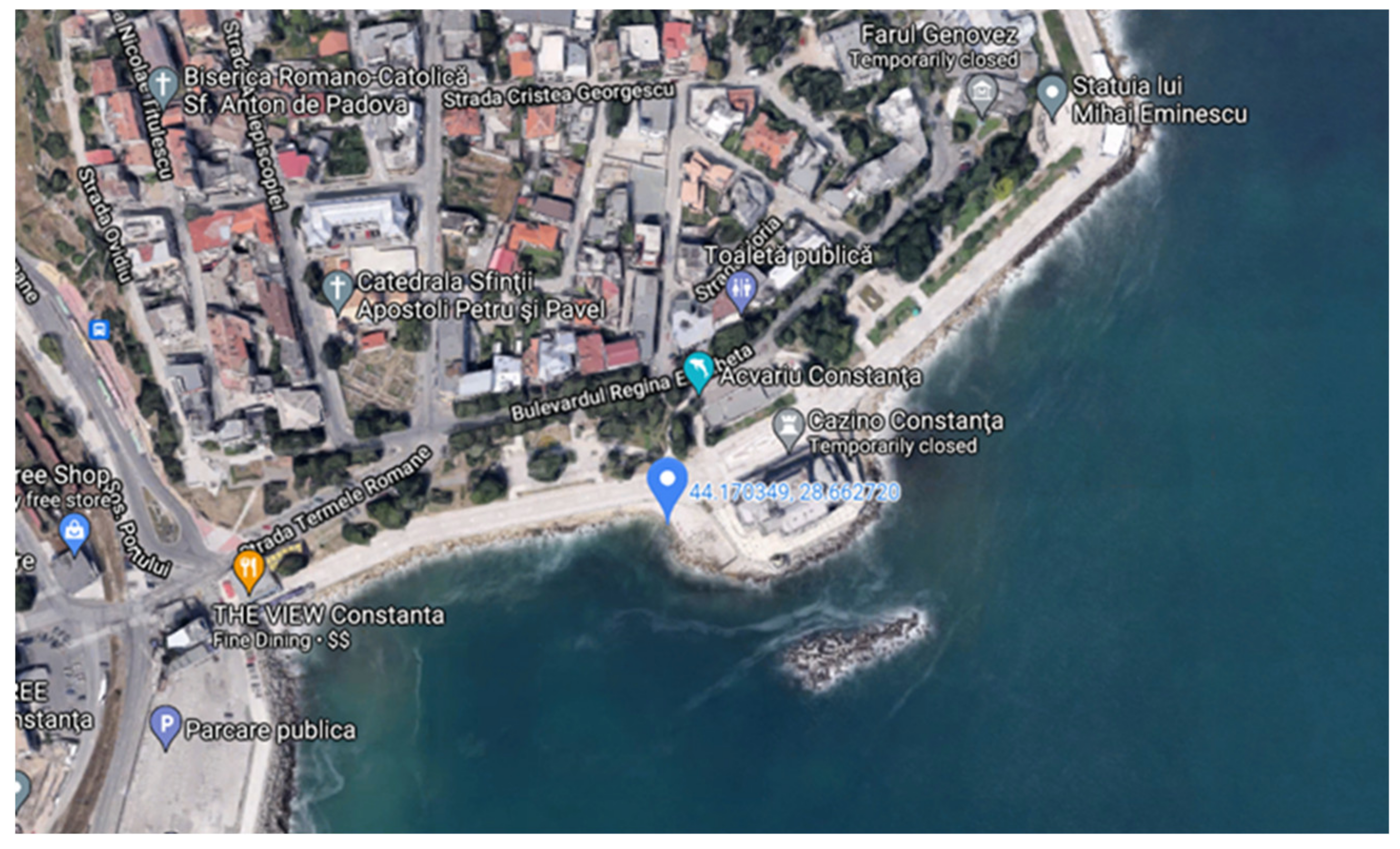
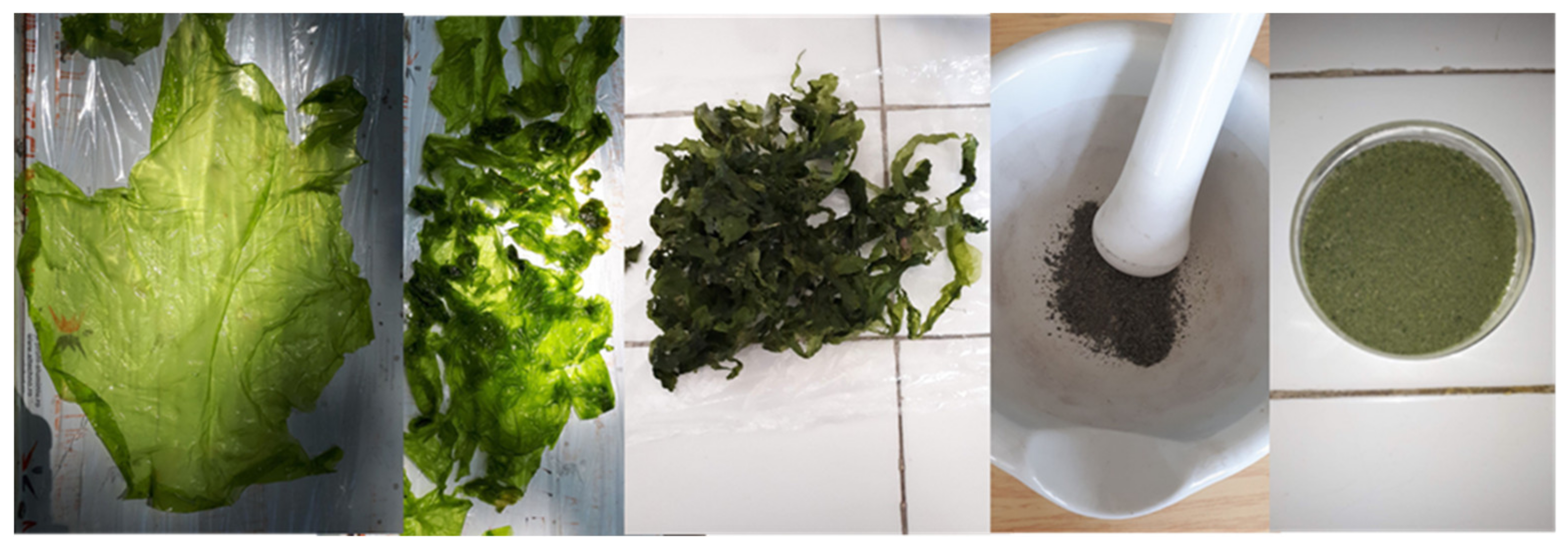
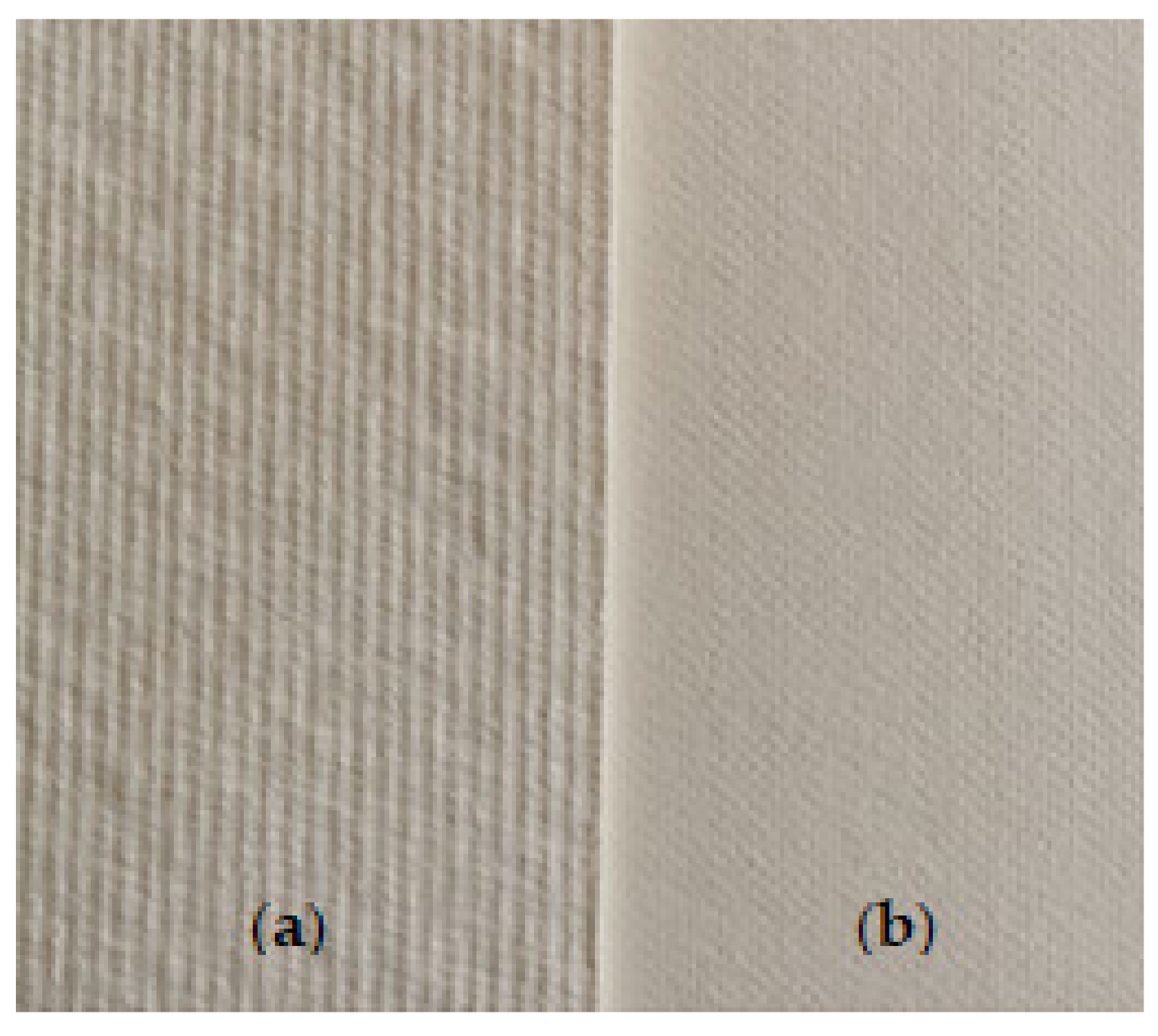
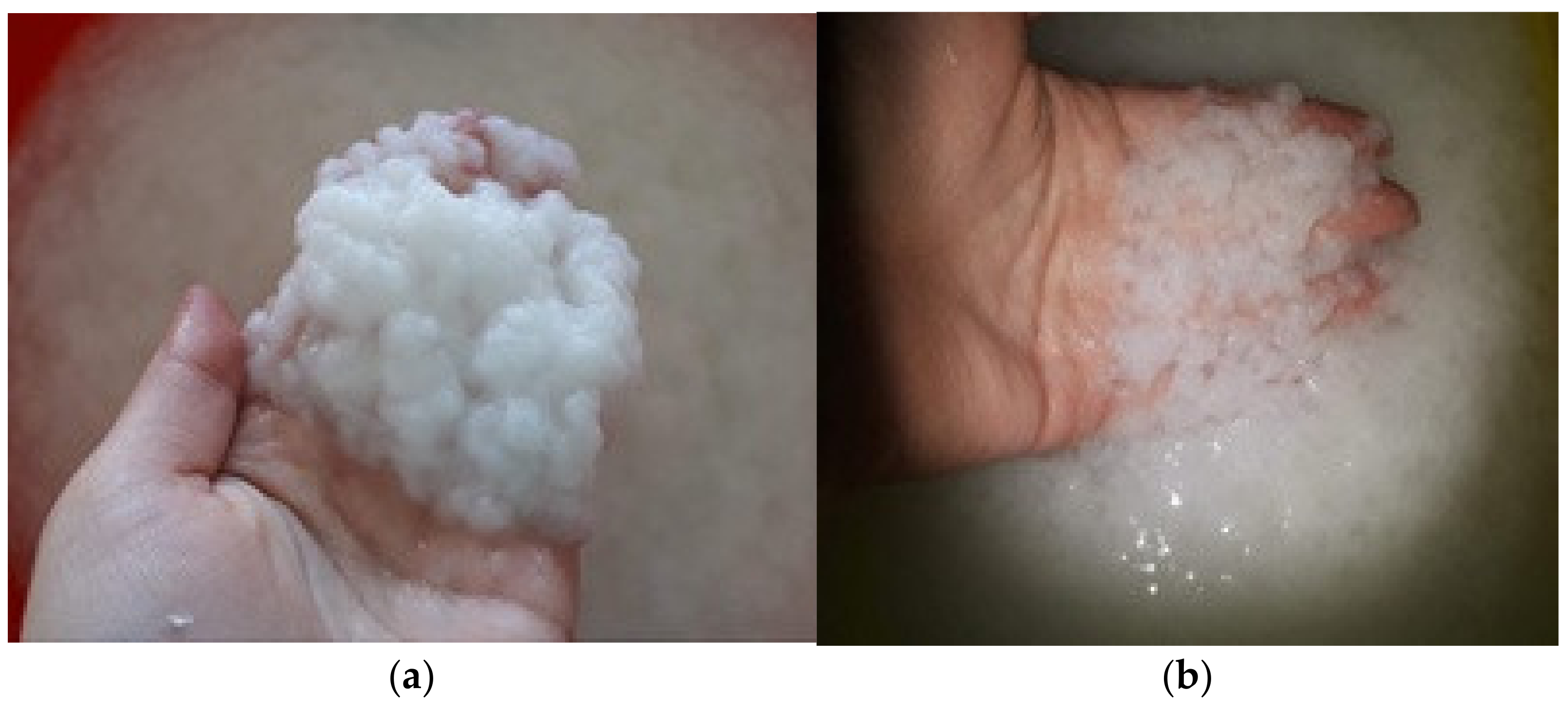

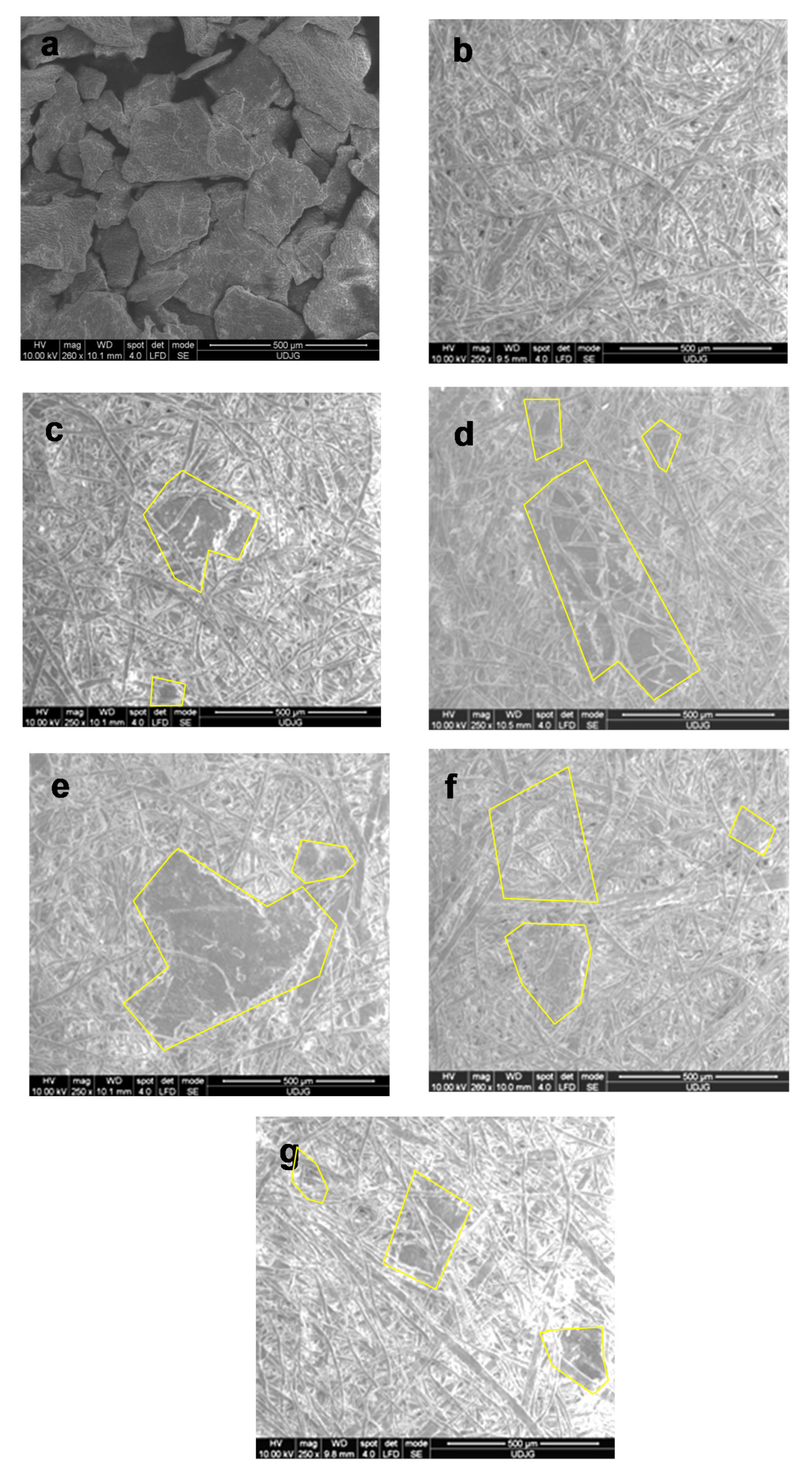
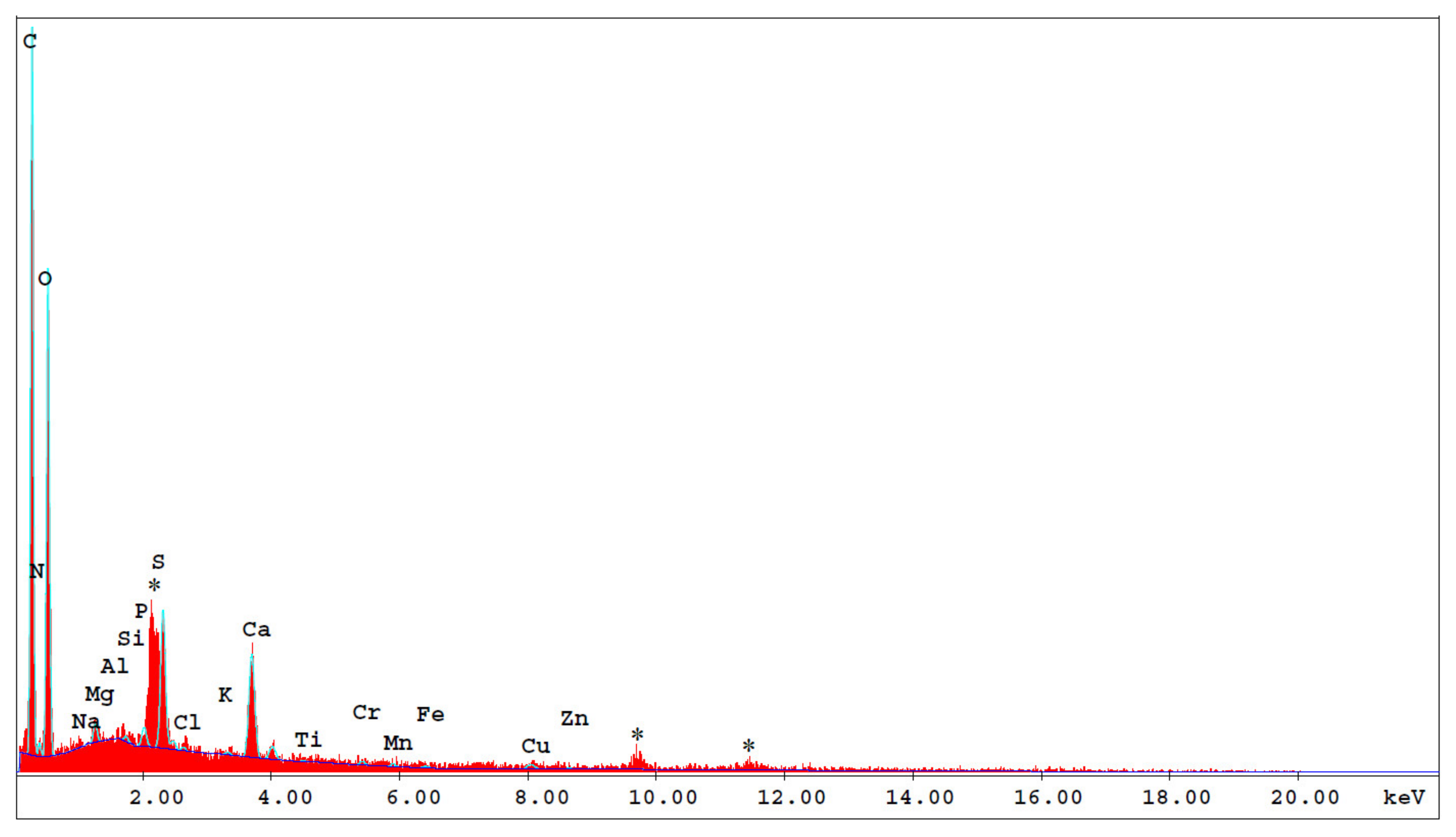
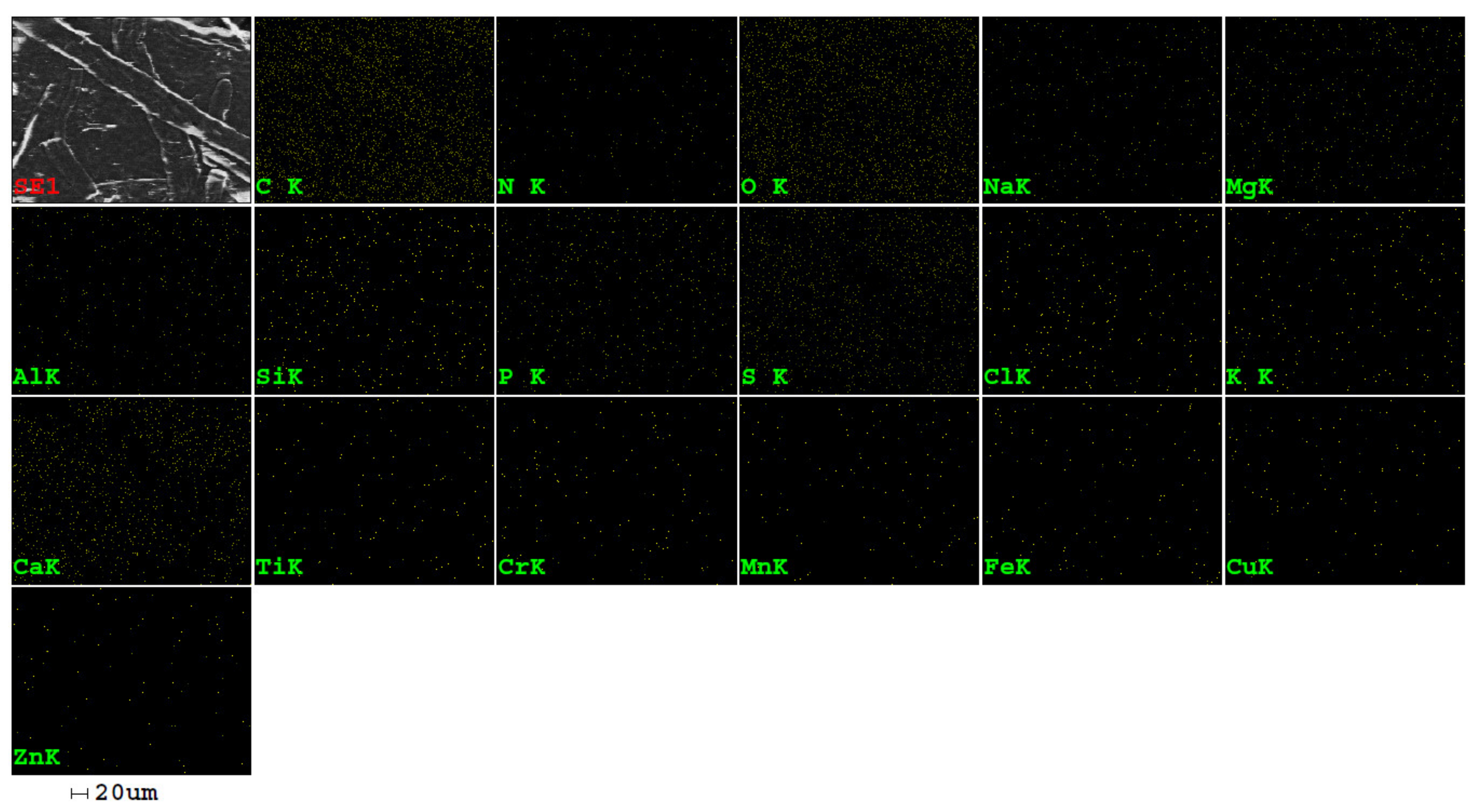
| Sample Coding | Addition | Grammage | Thickness | Apparent Specific Volume | Porosity | Smoothness | Ash Content | Breaking Load | Breaking Length | Tearing | Bursting Resistance | Folding Endurance | Water Absorptiveness Cobb 60 Index | Moisture | |||
|---|---|---|---|---|---|---|---|---|---|---|---|---|---|---|---|---|---|
| % Algae | g/m2 | µ | g/cm3 | s | s | % | N | m | mN | kPa | No. | g/m2 | % | ||||
| Front Side | Back Side | Dry | Wet | Dry | Wet | ||||||||||||
| P0 | 0 | 80.62 | 144 | 0.56 | 1.9 | 1.9 | 6 | 0.4 | 40.6 | 3.62 | 3422 | 305 | 560 | 143 | 13 | 165.38 | 4.95 |
| P1 | 0.5 | 80.33 | 142 | 0.57 | 2.5 | 2.3 | 6 | 0.42 | 41.01 | 3.78 | 3470 | 320 | 560 | 143 | 14 | 170.38 | 5.04 |
| P2 | 1 | 80.81 | 145 | 0.56 | 2.6 | 2.5 | 6 | 0.44 | 41.34 | 4.025 | 3476 | 338 | 580 | 147 | 15 | 176.63 | 5.14 |
| P3 | 2 | 80.63 | 143 | 0.56 | 2.6 | 2.5 | 6 | 0.49 | 43.96 | 4.16 | 3705 | 351 | 620 | 141 | 15 | 177.31 | 5.23 |
| P4 | 4 | 80.66 | 144 | 0.56 | 2.8 | 2.8 | 6 | 0.67 | 44.27 | 3.82 | 3729 | 322 | 600 | 141 | 15 | 185.06 | 5.45 |
| P5 | 8 | 80.47 | 142 | 0.57 | 3.2 | 3.1 | 6 | 0.93 | 39.73 | 2.35 | 3355 | 198 | 540 | 127 | 11 | 179.12 | 5.27 |
| Element | Concentration (wt.%) | ||||||
|---|---|---|---|---|---|---|---|
| Algae | P0 | P1 | P2 | P3 | P4 | P5 | |
| C | 48.86 | 60.42 | 55.81 | 56.34 | 57.03 | 56.80 | 54.62 |
| N | 5.76 | 2.50 | 3.05 | 2.41 | 2.63 | 3.01 | |
| O | 37.68 | 39.58 | 32.43 | 32.98 | 35.04 | 34.65 | 33.40 |
| Na | 0.32 | 0.13 | 0.18 | 0.17 | 0.29 | 0.13 | |
| Mg | 1.34 | 0.63 | 0.63 | 0.38 | 0.50 | 0.60 | |
| Al | 0.08 | 0.00 | 0.12 | 0.12 | 0.14 | 0.08 | |
| Si | 0.52 | 0.10 | 0.21 | 0.07 | 0.08 | 0.15 | |
| P | 0.04 | 0.31 | 0.25 | 0.13 | 0.24 | 0.32 | |
| S | 2.67 | 2.58 | 2.43 | 2.18 | 1.89 | 2.50 | |
| Cl | 0.03 | 0.06 | 0.15 | 0.00 | 0.00 | 0.10 | |
| K | 0.17 | 0.00 | 0.00 | 0.00 | 0.00 | 0.19 | |
| Ca | 1.84 | 3.23 | 2.65 | 2.07 | 1.67 | 2.71 | |
| Ti | 0.10 | 0.12 | 0.00 | 0.00 | 0.00 | 0.12 | |
| Cr | 0.06 | 0.14 | 0.00 | 0.00 | 0.00 | 0.11 | |
| Mn | 0.09 | 0.23 | 0.00 | 0.00 | 0.00 | 0.27 | |
| Fe | 0.26 | 0.40 | 0.13 | 0.13 | 0.16 | 0.44 | |
| Cu | 0.18 | 0.79 | 0.36 | 0.00 | 0.52 | 0.47 | |
| Zn | 0.00 | 0.56 | 0.54 | 0.27 | 0.42 | 0.79 | |
| Metal | Initial Wastewater | NTPA 001 | NTPA 002 | P0 | P1 | P2 | P3 | P4 | P5 |
|---|---|---|---|---|---|---|---|---|---|
| Cr total | 0.37 | 1.0 | 1.5 | 0.15 | 0.09 | 0.08 | 0.09 | 0.07 | 0.07 |
| Cu | 1.8 | 0.1 | 0.2 | 0.2 | 0.2 | 0.21 | 0.18 | 0.15 | 0.11 |
| Fe total | 6.14 | 5.0 | - | 0.07 | 0.04 | 0.05 | 0.03 | 0.03 | 0.03 |
| Zn | 1.92 | 0.5 | 1.0 | 0.22 | 0.17 | 0.10 | 0.11 | 0.08 | 0.09 |
| TDS | 468 | - | - | 436 | 434 | 422 | 422 | 419 | 420 |
| TSS | 2495 | - | 350 | 5 | 2 | 3 | 0 | 0 | 0 |
Publisher’s Note: MDPI stays neutral with regard to jurisdictional claims in published maps and institutional affiliations. |
© 2021 by the authors. Licensee MDPI, Basel, Switzerland. This article is an open access article distributed under the terms and conditions of the Creative Commons Attribution (CC BY) license (https://creativecommons.org/licenses/by/4.0/).
Share and Cite
Caprita, F.-C.; Ene, A.; Cantaragiu Ceoromila, A. Valorification of Ulva rigida Algae in Pulp and Paper Industry for Improved Paper Characteristics and Wastewater Heavy Metal Filtration. Sustainability 2021, 13, 10763. https://doi.org/10.3390/su131910763
Caprita F-C, Ene A, Cantaragiu Ceoromila A. Valorification of Ulva rigida Algae in Pulp and Paper Industry for Improved Paper Characteristics and Wastewater Heavy Metal Filtration. Sustainability. 2021; 13(19):10763. https://doi.org/10.3390/su131910763
Chicago/Turabian StyleCaprita, Florina-Cristiana, Antoaneta Ene, and Alina Cantaragiu Ceoromila. 2021. "Valorification of Ulva rigida Algae in Pulp and Paper Industry for Improved Paper Characteristics and Wastewater Heavy Metal Filtration" Sustainability 13, no. 19: 10763. https://doi.org/10.3390/su131910763
APA StyleCaprita, F.-C., Ene, A., & Cantaragiu Ceoromila, A. (2021). Valorification of Ulva rigida Algae in Pulp and Paper Industry for Improved Paper Characteristics and Wastewater Heavy Metal Filtration. Sustainability, 13(19), 10763. https://doi.org/10.3390/su131910763







